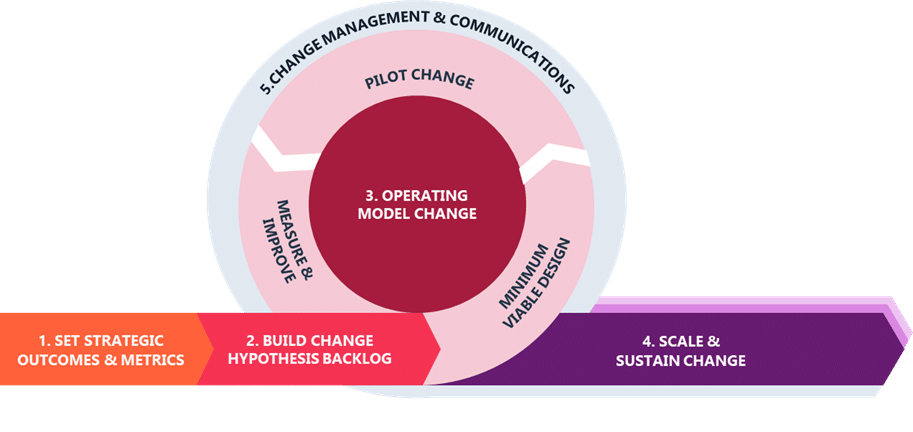We all follow patterns every day. The familiar routines where we know what we’re doing and the results we’ll get. But these patterns can become so comfortable that we fail to recognise that we’re not actually achieving what we set out to achieve. The pattern is in fact an anti-pattern*.
The way many organisations approach operating model change is full of anti-patterns, and therefore their initiatives are not likely to deliver the change, or value, needed.
Below we lay out the anti-patterns to avoid, and put forward new patterns for operating model change, based on principles of agility and product-led thinking.
The foundation of these patterns is our belief, based on real-world experience with clients, that it is operating model change – not operating model design – that delivers value.
Using change to deliver value
The traditional approach to reviewing an operating model – and the “one-size-fits-all” method used by many – is a linear process with a heavy weighting on “design”. We’ve written before about why beautiful operating model designs fail, but to summarise; the design takes so long that external and internal forces render it out of date before changes can be made, and leaders’ energy and focus atrophies as design turns to implementation, consigning the beautiful operating model design to the PowerPoint slides it exists within.
Constant operating model change underpins organisational agility, and this is now table stakes for organisations looking to survive in dynamic markets. There is a misconception of moving steadily between static transition states towards a “target” operating model over many years – this traditional approach is no longer fit-for-purpose.
Value is delivered when you make a change to your operating model that enables you to better deliver strategic outcomes, therefore the more efficient you are at making change, the faster you deliver value. So, a new approach is needed; anchored on strategic outcomes (not a “target state”) and focused on making change (not creating beautiful designs).
The patterns and anti-patterns for operating model change
To deliver a fresh approach for operating model change, we’ve considered the key “anti-patterns” persistent in the world of operating model projects, and defined the patterns that are now required.
Anti-Pattern
Pattern
“Target” operating model – setting a target state as the pre-determined outcome to deliver, regardless of changes in the environment you operate within.
Define strategic outcomes – your operating model must enable the strategic goals of your business. Use these as your “north star” to guide decision making throughout operating model change, instead of moving towards a static “target” design.
Detailed as-is analysis – months are spent understanding the current operating model in detail, despite the fact parts of it will be changing before any design work is done.
Rapid diagnostic – build enough of an understanding to develop hypotheses for what changes might enable the strategic outcomes. More detail is gathered during design where needed for specific areas.
Lengthy “whole model” design phase – a linear progression from high-level to detailed design for the whole operating model scope, with design decisions made by committee at the point of maximum uncertainty.
Prioritise minimum-viable design – identify where a change will be most valuable, build a minimum-viable design and pilot it to test value, iterating the design with real-world feedback.
Multi-year transformation programme – weeks (or months) are spent planning a large complex programme to deliver the new operating model design, with benefits delivered in large chunks towards the end of the plan.
Pilot changes: stop, pivot or scale – pilots are used to experiment with changes and quickly learn what does and doesn’t work. Pre-defined metrics determine whether pilots are stopped, scaled or require improvements. Value is delivered earlier, while risk is reduced.
Change management supports implementation – change management and communications expertise are brought in post-design to inform implementation planning, with communications only delivered at the point of change (after rumours have already set expectations and created resistance).
Change management influences priorities and design – the potential implications on behaviours, knowledge, culture and ways of working are factored into prioritising hypothesis and designing changes. Communications run ahead of rumour and emphasise the benefits of the experimental and incremental approach being taken.
Success measured against designs – the success of the operating model change is measured against whether or not the target design is delivered.
Measure success against metrics that matter – metrics for Strategic Outcomes are defined up-front and operating model change is deemed successful if it improves these metrics, regardless of adherence to original designs.
A new approach
This approach embeds the right patterns for success and can be flexed to the context and scope of the operating model, as well as the capacity and maturity of an organisation to deliver change.

1. Set strategic outcomes and metrics
Make sure there’s real alignment upfront about what you’re trying to achieve through changing your operating model, and which metrics will show you’re moving in the right direction. Your strategic outcomes replace a “target” operating model design to act as a decision guide for change – they should determine what you want to achieve but leave how you achieve it flexible.
Tip: We recommend setting three to five outcomes that consider value, quality, speed, risk and ways of working.
2. Build change hypothesis backlog
Develop a set of hypotheses for operating model changes that will move you from your current situation towards your outcomes. Keeping an open mind is critical here – hypotheses are ideas to test, not certainties. Success criteria is defined for each to make “stop, pivot or scale” decisions data-driven, not subjective. The backlog drives your change activities and is ever evolving, so don’t waste time at this stage working through detail that is likely to emerge later.
Tip: Prioritise the backlog around alignment to outcomes, expected value and risk/complexity.
3. Get going with your priority hypotheses
Design work is kept to a minimum, using small cross-functional teams (critically, including change management – see point 5) to rapidly understand a problem area and design a potential Changes are piloted within clearly defined parameters and success criteria measured. Designs can be improved (and re-tested), stopped or scaled when successful. Multiple changes can be designed and piloted in parallel, with dedicated roles managing dependencies and removing blockers.
Tip: Change “pre-mortems” are used to bring stakeholders together to identify, manage and accept risks collectively, rather than months being spent in detailed design workshops.
4. Scale and sustain change
Successful changes are scaled across the operating model, using an incremental or phased approach appropriate to the change. While a successful pilot will significantly de-risk making operating model change at scale, changes may encounter other operating model impediments (note: this is not unique to the approach proposed here). New hypotheses are developed to remove these impediments and added to the backlog.
Tip: Continue to monitor your success metrics and use change management interventions to course correct any deviations from the expected results of the change.
5. Embed change management and communications throughout the approach
Using our ChAgile™ methodology to influence backlog prioritisation and minimum viable designs, and deliver interventions to pilot, improve and sustain operating model changes.
Tip: Think big with communications events and channels to help teams understand the outcomes, embrace the experimental mindset, and remove the myth of a “target” state or that any change will perform exactly as expected.
Shifting mindsets for success
This approach requires a mindset shift, with leaders setting the example for those involved. They must convey confidence and certainty in what they what to achieve (the strategic outcomes) and be comfortable with some ambiguity in how they will achieve it (the hypotheses).
There are three key areas where a mindset shift is required:
1. Let go of the “target”
Removing the safety net of the ‘’target state’’ can be uncomfortable for some stakeholders, particularly those with previous operating model experience. Stakeholders need to embrace the strategic outcomes as the “north star” for operating model change – pointing to this, not a carefully crafted PowerPoint diagram, as what they are trying to achieve.
2. Think like a scientist
A shift from developing solutions or recommendations (e.g., we need to make a change to X) to framing hypothesis to be tested (e.g., we think that A will make B better, and we can test that by measuring C).
3. Failure means learning
Organisations are complex systems, so predicting with certainty how each change will impact the whole system is impossible. Risks are managed by de-scaling changes and carrying out impact assessments, but the unknown unknowns will always exist. Leaders need to embrace unforeseen results as learnings and celebrate these alongside traditional successes.
Seeking greater agility and value delivery
A fresh approach to operating model change is needed for organisations seeking greater agility and successful value delivery. Hypotheses for change are prioritised against strategic outcomes, piloted and measured to improve minimum viable designs, and scaled based on data-driven evidence of value. Critical to the success of this approach is embedding change management throughout the process, with change leaders embracing an experimental mindset.
We believe this approach will help organisations deliver value quickly in a world where operating model change is constant. To talk to us about the approach described above and our experience helping clients deliver valuable operating model change, get in touch.


